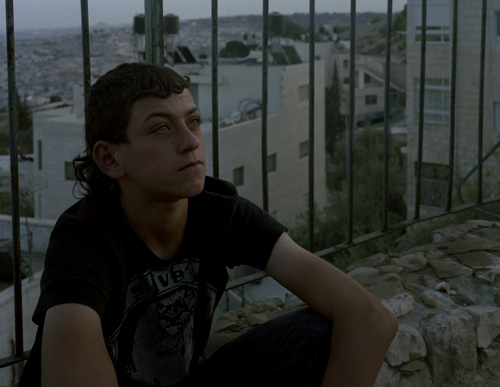Trained as an anthropologist, Valerie Jouve has brought a researcher's focus to her career as a photographer. Since the early 1990s, she has used her camera to study society and the human presence in the urban environment. Until September 13, the Pompidou Center is showing "En Attente" ("Waiting"), 30 photographs taken in 2008 and 2009 that represent the first part of her project on Arab communities in the Palestinian autonomous territories.
Jouve juxtaposes photos of very different size and feel, taking the viewer on an intensely emotional and thought-provoking journey. ARTINFO France recently sat down with the photographer to talk about her experience documenting the lives of Palestinians, and her return to the French museum scene.
See photos from Valerie Jouve's show at the Pompidou and visit the Q&A where she discusses her project on ARTINFO.

Copyright Valerie Jouve / Courtesy Galerie Xippas
With this exhibition you have returned to a large-scale French institution after a 10-year absence.
Since 2003, I've withdrawn a bit so I could construct my work according to a rhythm that would be productive. However, while I haven't shown my images in a large institution here in France, I did do so abroad. Having two or three shows per year lets me be inside my work, instead of being focused on showing it.
Your images are more about emotional perception than pure reporting. Can you describe your approach?
When I talk about the time that I'll need, it includes moments that are not productive. I don't walk up to places and people with my camera. I follow the time of real life and chance meetings so I can structure my approach. When I start producing images, I already have a pretty specific idea of what they will add up to. For this exhibition at the Pompidou Center, the emotional perception is strong because this was my first encounter with this country. I think I will have to work on this subject for two or three more years so I can explore it more in depth. Unlike reporters, I'm not about current events but I'm much more about the representation of an identity.
Why did you decide to photograph the Palestinian autonomous territories?
Initially, I was invited to do a project on Israeli territory, and I crossed the green line to discover, to my astonishment, a country that has not succeeded in being recognized but which I identified as such, with its own culture, its history, and its people. So I decided to work on both countries, Israel and Palestine, separately. My images of Israel will be shown later -- they are part of a group project.
You don't show the conflict.
That's right. In this project, many elements echo the approach that I constructed from the beginning, specifically finding zones that escape social control or even the control of power structures. The names of some images, such as "Characters," contrast with other realities, such as "Facades," for example. The power of the other is felt in the folds of Palestinian society. I don't need to show the conflict, I prefer to focus on the proud resistance of a people.
What have you learned from this experience?
I absolutely must continue so that I can go further, because I'm not only exploring Palestine but, through it, an entirely new logic of the world that we see arriving in the West. I have the feeling sometimes that this is a valid field of socio-political experimentation that is usable for our western world. Because it's really the West that came to settle in the Middle East. By showing the specific nature of a place, I am trying -- as I always do -- to emphasize its universal quality. The world is round and we're not as separated as some would have us believe. I also came to seek a story of colonization. In France, we experienced terrible times but we have a hard time shedding light on that history. While the Algerian War was violent for the French, I think that for the Algerians the colonial period was much more serious, and more unjust.
Your photos show the city and its people on a human scale and they are arranged in the exhibition space according to the angle that you chose at the moment of the shot. Why?
As always, I approached this exhibition wanting to make the images talk and to let them inhabit the space. The goal is not to present my new work but to lead the viewer to question our world and his or her own place in it. So the space is inhabited by a special kind of energy. It bathes and surrounds the viewer who can temporarily make it his or her own.
Why did you call the exhibition "En Attente," or "Waiting"?
It took a long time to choose the title. I really didn't want it to be something fixed or something that would explain too much. I think that it was Quentin Bajac who suggested "En Attente" while we were discussing plans for the exhibition. I thought it was perfect, because on the one hand it goes with a project that is starting -- this exhibition is not the end-result of my work in Palestine, because it's just begun -- and that will have more to follow. On the other hand, it also describes the situation of this territory, which is precarious and waiting for a viable solution.
See photos from Valerie Jouve's show at the Pompidou and visit the Q&A where she discusses her project on ARTINFO.
- Emilie Gouband, ARTINFO France
Follow ARTINFO on Foursquare: http://foursquare.com/artinfo